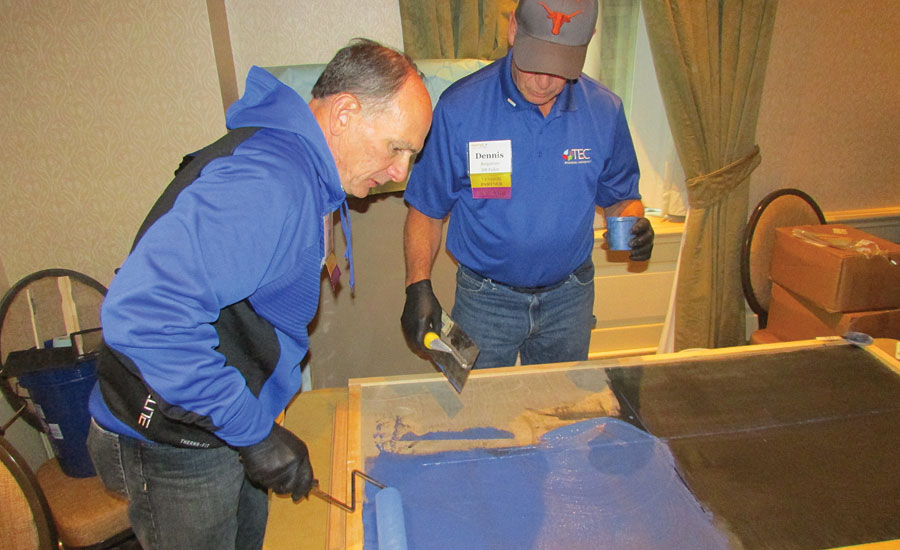Starnet 2015 Fall Meeting: Discussing the Future of Flooring Installation

(From left) H.B. Fuller Construction Products’ Ron Loffredo and Dennis Bergstrom demonstrate the new one-part LiquiDam EZ moisture mitigation system. The company launched the new product during the Starnet show.









The importance of qualified installation and the issues impacting it were key topics of conversation at Starnet’s Fall 2015 Membership Meeting in Boston. The first day of the show was devoted to a four-hour general session on moisture mitigation with a panel of three top concrete experts, followed by an evening of tabletop displays devoted to moisture mitigation products. On the second day of the show, the topic of attracting and retaining talented installers was the focus of one well-attended session.
Jeanne Matson, Starnet’s president and CEO, kicked off the moisture mitigation presentation by stating, “This is a critical—if not the most critical—issue facing the industry today.”
Mike Tracy, Ardex Americas business development manager, whose company sponsored the presentation along with Armstrong, then introduced the three panelists: Eldon Tipping of Structural Services, Allen Face of Allen Face & Associates, and Peter Craig of Concrete Constructives.
Tipping discussed concrete slabs in terms of both flatness and levelness. “A skim coat will fix the flatness problem but not the levelness problem—that’s primarily a function of deflection of the structural system.”
Face was frank about the challenges between the concrete and flooring sides of the industry. “As long as we allow Division 3 and Division 9 to be at odds with each other, we can have this seminar this year and the year after that and nothing is going to change. The problem is not flatness. It’s that you’re using a straightedge and only checking 10 feet. The concrete industry uses F-numbers, which measure floor flatness and floor levelness applicable to the surface. Once you drop the straightedge, and start getting into the science, then we can make some headway.”
Craig said the best approach to dealing with moisture mitigation is taking a preemptive approach instead of a reactive one. “Very seldom, if ever, does the concrete slab dry to the level that flooring manufacturers require for installation of their product. A moisture mitigation strategy is needed. You inherit things you don’t have control over, so have that discussion immediately so it doesn’t become adversarial once it’s too late.”
He added, “If you are performing the calcium chloride and RH tests and they’re giving you conflicting information, RH always rules. If your only piece of information is the moisture emission rate, that’s insufficient. You need to have the internal relative humidity of the slab to get the full picture.”
Attracting installers
Ed Woolley of Flooring Solutions, Billy Dotson of Vector Concepts, and John Becker of Floors by Becker discussed methods for attracting and retaining new talent. It comes down to a respectful relationship between the contractor and installer, where the installer feels valued and wants to do his or her best work.
Becker said one of the best ways to find emerging talent is in high schools. “We tell these kids, you go to college, build up $150-200K in debt, then try to support a house, a car, a family on $45-50K a year. It just doesn’t work. However, if you get into the trade at 18, by 23 you can be making $70K a year.”
He added, “This method takes time. You need to reach into different demographics, become almost a father figure and mentor to these kids. We’re talking to lots of kids of African American and Asian descent. They talk to their communities, they understand their culture, and they help you reach into different demographics.”
Dotson said it’s important to treat installers with integrity and respect. “Installers are the ones who are going to see the customer. They are our face on the jobsite. Our biggest asset for attracting people is through word of mouth and our loyalty to them.”
He also embraces a more diverse workforce. “Here in Texas, we’re past the culture shock. There just aren’t a lot of non-Hispanic installers anymore, and we’ve embraced that now. In fact, some of them are our best installers. There just aren’t a lot of people who look like me coming into the business anymore.”
Woolley wrapped up the conversation by stressing another important aspect of the future of a business—an exit strategy. “If you don’t have an exit strategy in place, take three to five years to get one going. We don’t often get to choose our exit strategy. Establish the senior management team you want to become the face of your business and give it time.”
He added, “We do not know what tomorrow holds. Entrust your future leaders—they want to know the vision you have for the future of your company. It’s not easy. We all have work to do.”
Starnet is set to hold its 2016 Spring Meeting from April 14-17 in Miami. For more information, visit starnetflooring.com.
Looking for a reprint of this article?
From high-res PDFs to custom plaques, order your copy today!












